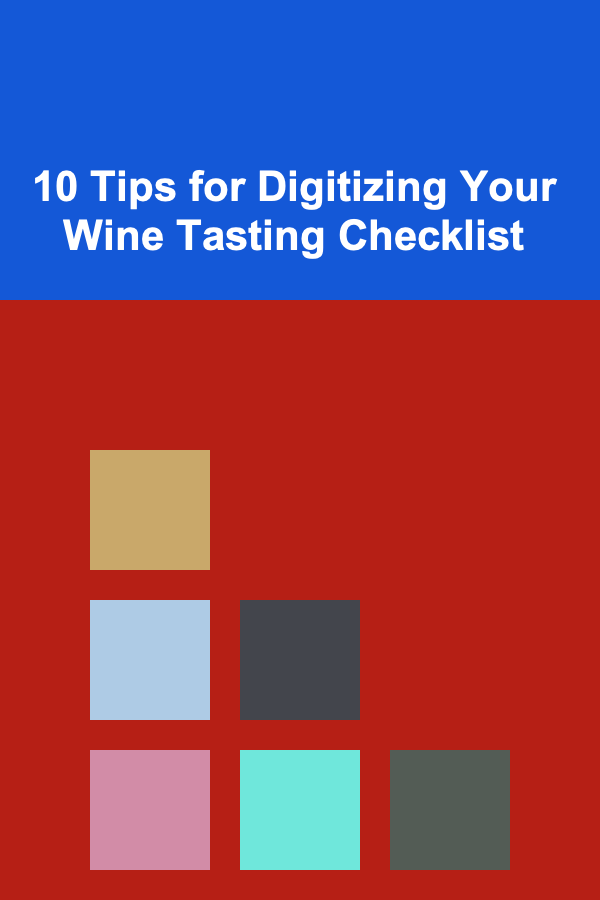
10 Tips for Digitizing Your Wine Tasting Checklist
ebook include PDF & Audio bundle (Micro Guide)
$12.99$5.99
Limited Time Offer! Order within the next:

Wine tasting is an art that involves not just appreciating the taste, aroma, and appearance of wine but also keeping track of all the details that make each wine unique. Whether you're a casual wine enthusiast or a seasoned connoisseur, having a method for documenting your wine experiences is essential for improving your knowledge and refining your palate.
In the past, many wine lovers would write their tasting notes on paper or in physical notebooks. However, with the rise of digital tools, it's easier than ever to record, organize, and review your wine tastings. Digitizing your wine tasting checklist can offer numerous benefits, such as easy access to your tasting history, the ability to share your notes, and the convenience of having everything in one place.
In this article, we'll provide 10 tips for digitizing your wine tasting checklist, so you can take full advantage of modern technology while enhancing your wine-tasting experience.
Choose the Right Digital Tool
The first step in digitizing your wine tasting checklist is to choose a tool that suits your needs. There are various apps and platforms designed specifically for wine enthusiasts, ranging from simple note-taking apps to sophisticated wine tracking systems.
Tips for Choosing the Right Tool:
- Wine-Specific Apps: Apps like Vivino, CellarTracker, and Delectable are popular choices for wine lovers. These apps allow you to scan labels, add tasting notes, and rate wines while offering recommendations based on your preferences.
- Note-Taking Apps: If you prefer a more flexible approach, apps like Evernote, OneNote, or Google Keep can be great for creating customized checklists and notes.
- Spreadsheet Software: If you're more of a numbers person, Google Sheets or Excel can offer a customizable solution for tracking wine data, including details like vintage, region, price, and tasting notes.
The key is to find a tool that fits your organizational style and enhances your experience without overcomplicating things.
Standardize Your Tasting Checklist Format
To make your wine tasting notes consistent and easy to review, it's important to standardize the format of your checklist. This ensures that every time you taste a wine, you capture the same type of information, making comparisons easier over time.
Tips for Standardizing Your Format:
- Basic Information: Include fields for the wine's name, vintage, region, and variety. These details are essential for identifying the wine in the future.
- Tasting Notes: Standardize the categories you use to evaluate the wine, such as appearance, nose (aroma), palate (taste), and finish. You might also want to rate the wine based on overall enjoyment or quality.
- Rating System: Decide on a rating system, such as a 1-10 scale or a 5-star system, to help quantify your opinions and make it easier to compare wines later.
- Additional Information: If you're tracking specific attributes, such as food pairings or whether you would purchase the wine again, include these fields in your checklist.
By creating a standardized format, you ensure that your digital wine tasting checklist is organized and uniform, which can make reviewing your wine notes much more efficient.
Incorporate Photos of Wine Labels
A picture is worth a thousand words, especially when it comes to wine. Including a photo of the wine label in your digital checklist makes it easier to remember specific bottles, especially if you taste many wines over time.
Tips for Adding Photos:
- High-Quality Images: Take clear, high-quality photos of the front and back of the wine label. This will help you remember details such as the winery's story, tasting notes, and any unique features of the label.
- Use Camera Apps with Wine-Scanning Features: Some apps, like Vivino, allow you to take pictures of wine labels and automatically gather information such as wine type, vintage, and user reviews. This can save you time and effort while providing additional insights.
Adding photos enhances the utility of your wine tasting checklist and gives you a visual reference for each bottle.
Include Location-Based Tracking
Wine is all about place --- terroir, or the environment in which a wine is produced, plays a major role in its characteristics. Tracking the origin of each wine you taste can help you understand how different regions affect flavor profiles and help refine your palate over time.
Tips for Location-Based Tracking:
- Use Geotagging: Some wine apps automatically track the location of your tastings using geotagging. This allows you to visualize where each wine comes from, which can be especially helpful if you're traveling or tasting wines from different regions.
- Add Region and Winery Information: Include specific details about the wine's vineyard, winemaker, or growing region. This will help you recall important aspects about where the wine was produced and how it might compare to others from the same area.
Location-based tracking adds depth to your digital checklist and enhances your understanding of regional wine characteristics.
Rate Wine on Multiple Parameters
To gain a more nuanced understanding of each wine, consider rating it on multiple parameters, rather than just giving an overall score. This allows you to track what aspects of the wine you like or dislike, making it easier to select wines that align with your preferences in the future.
Tips for Rating Wine on Multiple Parameters:
- Appearance: Assess the color, clarity, and viscosity of the wine.
- Aroma: Evaluate the intensity, complexity, and balance of the wine's smell.
- Taste: Rate the balance of sweetness, acidity, tannins, alcohol, and fruitiness.
- Finish: Assess how long the wine lingers after swallowing and the quality of the aftertaste.
- Overall Enjoyment: Include an overall rating to summarize your impression of the wine.
By tracking these parameters, you can develop a deeper understanding of what makes certain wines stand out and refine your future wine choices.
Use Cloud Storage for Easy Access and Backup
The benefit of digitizing your wine tasting checklist is that you can access it anytime, anywhere. To ensure you don't lose your notes, use cloud storage to store your digital checklist, allowing you to back up your information and access it from multiple devices.
Tips for Using Cloud Storage:
- Google Drive: Google Drive is a convenient, free option that allows you to store your checklist and access it from your phone, tablet, or computer.
- Dropbox: Dropbox is another excellent cloud storage solution for organizing and backing up your wine tasting checklist.
- iCloud: If you're an Apple user, iCloud provides seamless integration with your devices and can be used to back up your wine tasting notes.
Cloud storage ensures that your wine tasting records are secure and accessible whenever you need them.
Share Your Wine Tasting Experience
One of the advantages of digitizing your wine tasting checklist is the ability to share your experiences with others. Whether you're sharing your notes with friends, fellow wine enthusiasts, or on social media, a digital format makes it easy to communicate your thoughts and recommendations.
Tips for Sharing Your Wine Tasting Notes:
- Social Media: Many wine lovers share their tasting notes on social media platforms like Instagram, where they post photos of wines with descriptions and ratings.
- Wine Review Websites: Platforms like Vivino and Delectable allow you to post your tasting notes and review wines, where other users can read your insights and provide their own.
- Personal Blog or Website: For those who want to share their wine tasting experiences more extensively, creating a personal blog or website is an option.
Sharing your wine experiences not only allows you to connect with others but can also provide useful feedback on your wine preferences.
Track Wine Aging Potential
Some wines improve with age, while others are best enjoyed young. Tracking the aging potential of wines you taste can help you make informed decisions about how long to keep a bottle before drinking it.
Tips for Tracking Aging Potential:
- Note the Aging Potential on Your Checklist: Include fields in your checklist to note whether the wine has good aging potential, based on your assessment or the winery's recommendations.
- Keep Track of Cellar Conditions: If you're storing wines to age, note their cellar conditions, including temperature and humidity, so you can track how these factors may affect the wine's aging process.
Tracking wine aging potential helps you plan your future tastings and collections.
Create Custom Wine Tasting Themes
Wine tasting can be a fun, thematic activity, whether you're exploring wines from a specific country, vintage, or grape variety. Digitizing your checklist allows you to create custom themes and track your experiences within those themes.
Tips for Creating Themes:
- Regional Tastings: Explore wines from specific countries or regions, such as Napa Valley or Bordeaux. Track your notes to see how wines from different areas compare.
- Varietal Tastings: Choose a particular grape variety, such as Cabernet Sauvignon or Pinot Noir, and taste wines made from that grape. Note the differences in flavor, body, and acidity between wines made from the same grape but different regions.
- Vintage Comparisons: Compare wines from the same region but different vintages. Track how the wine evolves over time and note differences in flavor profiles.
Custom themes add variety to your wine-tasting experience and make it easier to compare wines with similar characteristics.
Review and Reflect on Your Tasting Notes Regularly
The true benefit of digitizing your wine tasting checklist comes when you review and reflect on your notes regularly. This helps you build a deeper understanding of wine and refine your personal preferences.
Tips for Reviewing Your Notes:
- Look for Patterns: As you taste more wines, look for patterns in the types of wines you enjoy. Do you prefer red wines over whites? Do you enjoy wines with higher acidity or lower tannins?
- Adjust Your Preferences: Use your notes to adjust your wine purchasing decisions. If you consistently rate certain wines highly, consider seeking out more from those producers or regions.
- Set New Goals: Based on your reflections, set new wine-tasting goals. For example, you might want to explore wines from a different region or increase your knowledge of a particular grape variety.
Reviewing your notes regularly helps you refine your palate and gain a greater appreciation for the complexities of wine.
Digitizing your wine tasting checklist offers numerous benefits, from better organization to easier sharing and long-term tracking of your wine journey. By following these 10 tips, you can enhance your wine-tasting experience, deepen your knowledge, and continue refining your palate. With the right tools and a thoughtful approach, you'll be able to create a digital record of your tastings that you can refer back to for years to come.
Reading More From Our Other Websites
- [Personal Finance Management 101] How to Optimize Your Credit Score for Better Financial Opportunities
- [Home Soundproofing 101] How to Build a Sound Proof Room: Essential Steps and Materials
- [Organization Tip 101] Flooring vs. Tiling: Which is Right for Your Home?
- [Personal Finance Management 101] How to Manage Debt Effectively and Build Your Credit Score
- [Home Soundproofing 101] How to Soundproof Floors from Upstairs Noise
- [Home Budget Decorating 101] How to Make Your Small Space Feel Bigger with Smart Decor Choices
- [Home Rental Property 101] How to Handle Rent Increases and Stay Competitive in the Market
- [Personal Care Tips 101] How to Use Toothpaste to Treat Minor Gum Irritations
- [Personal Care Tips 101] How to Choose the Best Beauty Supplements for Personal Care
- [Home Renovating 101] How to Achieve a Modern Bathroom Remodel on a Budget

How to Involve Children and Pets in Your Wedding Plans
Read More
How to Sell Your Antique Furniture Through an Online Auction: An Actionable Guide
Read More
How To Trace the Origins of Human Civilization
Read More
How To Manage Your Investments Through Different Economic Cycles
Read More
How to Get Better at Super Smash Bros. Melee
Read More
Investing in Penny Stocks: A Deep Dive into High Risk, High Reward
Read MoreOther Products

How to Involve Children and Pets in Your Wedding Plans
Read More
How to Sell Your Antique Furniture Through an Online Auction: An Actionable Guide
Read More
How To Trace the Origins of Human Civilization
Read More
How To Manage Your Investments Through Different Economic Cycles
Read More
How to Get Better at Super Smash Bros. Melee
Read More